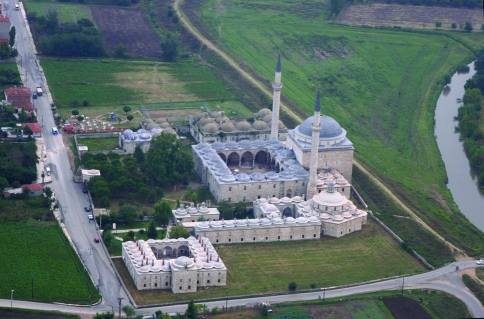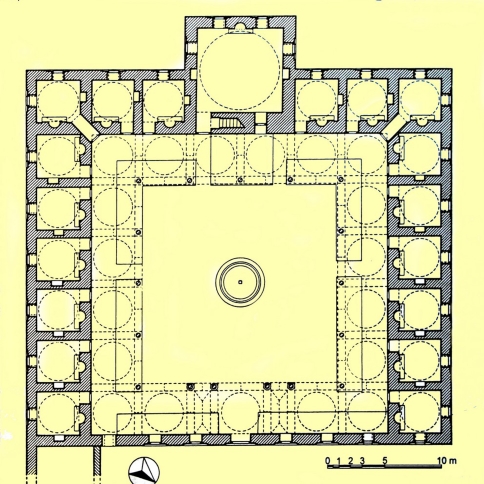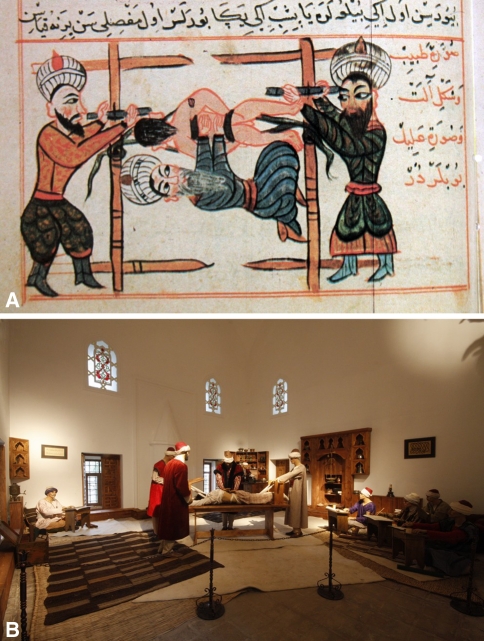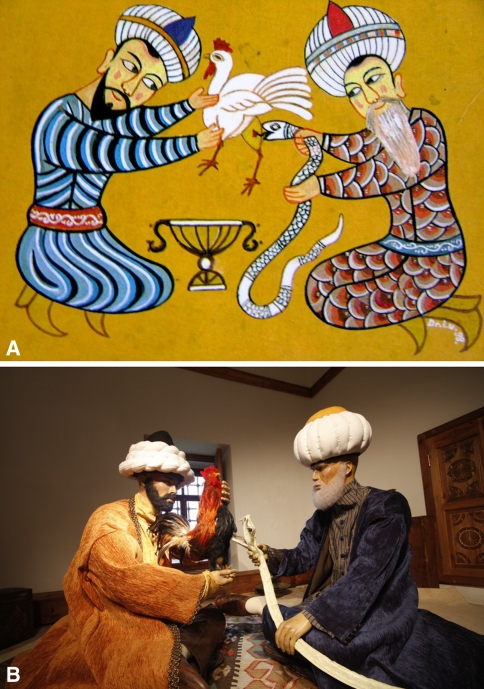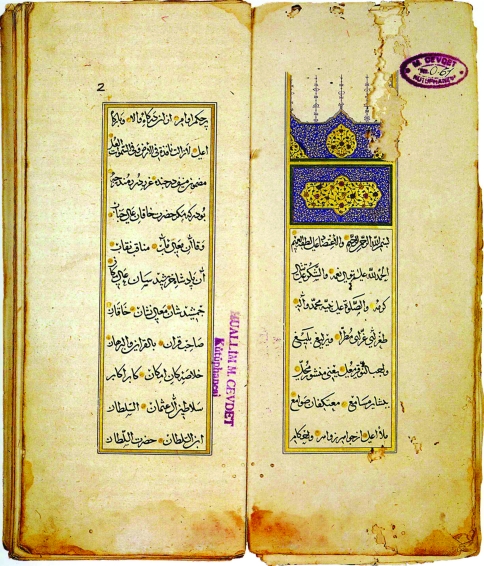Abstract
During the 8th to 13th centuries, Islamic medicine went through a golden age which influenced medical education and practice in the Ottomans, who conserved fundamental features of Islamic civilization. A külliye is an Ottoman architectural concept that designates a complex with a central mosque and a series of ancillary buildings surrounding it. Sultan Bayezid II Külliyesi of Edirne, Turkey is an early characteristic example with its sections, and in particular, with the medical school and hospital. The other constructed units were built to complete the hospital service in social, cultural, religious and financial aspects. This foundation (vakıf, waqf in Arabic) of health was a trust with deeds that contain notable information regarding hospital management, and the duties, responsibilities, qualities, and proficiency standards requisite for physicians. The Külliye, established in the 15th century, provided substantial contributions to medical and scientific history, and patient care. Together with the history of the Külliye, I will focus on the medical books of the period, in particular works of Şerefeddin Sabuncuoğlu who used the Turkish language instead of Arabic and color illustrations and his two books which were the main medical books of the period combining knowledge of Greek, Roman, Arabic, and Turkish acquirements.
Introduction
The science of medicine has historical roots from the West and East, with the most critical phases being the establishment of educational institutions, including hospitals and schools. The institutional education of medicine took its first steps when the priest-physicians trained in the temples built in the name of god of healing, Asclepius, on the islands on both sides of the Aegean Sea [5]. It is accepted that the works of Hippocrates (BC 460-370), the father of modern medicine based on observation, who was born on the island of Cos which is only 4 km from the coast of Bodrum, Turkey, have been important sources to the Islamic world, Seljuks, Ottomans, and the Western civilizations. The works of Galen (AD 129–200) were housed at the Pergamon School, currently in Bergama-West Anatolia, formerly one of the most important medical schools. Persian and Indian medical heritage also was conserved, developed, and then transferred to Islamics and Greeks [3, 5].
During the 8th to 13th centuries, Islamic medicine went through remarkable developments, which later influenced medical education and practice in Europe. This golden age was based on several factors: Muslims followed the guidelines of the Prophet studying and searching for knowledge, communication improved because the empire united extensive geographic areas where the Arabic language became a unifying factor, and scholars traveled to teach or share ideas. During the same period, translations from Greek, Latin, and Chinese into Arabic were numerous. Finally, The House of Wisdom, an academic institution serving as a university, was established in Baghdad in 1004 AD [3]. Jundi-Shapur hospital is the first example of the early academic medical centers. It was established by Khusraw (Chosroes) Anushitawan in approximately 555 AD at Jundi-Shapur located in southwestern Persia [9]. One of the largest institutions of the period was Al-Mansouri Hospital built in Cairo in 1284 AD and which had a capacity of 8000 beds. During the golden age, many libraries and hospitals in Damascus, Baghdad, Cairo, and Andalusia (Southern Spain) were constructed. Decline is an historical reality and after Cordoba fell to Spanish Christians in 1236, and Baghdad to Mongols in 1258, the golden age ended [3].
Madrasah (Medrese), which means “the place where science is learned” in Arabic, passed from the Seljukians to the Ottomans. Çifte Medrese, which was built by Kaykhusraw I (?-1210 AD) as a hospital and school, is the oldest academic medical center in central Anatolia established by Seljukian Turks. It was dedicated to his sister Gevher Nesibe Sultan who died at a young age of tuberculosis. Construction on the hospital began in 1024 and was completed in 1206. After the hospital opened, at the east side a medical school was built that was completed in 1214 by Kaykaus I (?-1220 AD) who also constructed Şifaiye Medresesi, a hospital and medical school in Sivas in 1217 [13].
The first secular medical school in Europe was Salerno Medical School of Italy at the end of the 9th century. Students from all over Europe read the books of Hippocrates and Galen translated from Greek into Arabic and then from Arabic into Latin. The famous teacher of this school was Constantine the African, who learned medicine through his journeys from Syria to India and knew Arabic and Latin. With the spread of Christianity and its gaining an institutional identity, the education and practice of medicine went under the influence of the Christian church and its clergymen [12]. Although surgery was disapproved of by the church during that period [5], it was quite prestigious in the Islamic culture. The monks were forbidden to be surgeons as surgery was regarded as a kind of slaughter. For instance, Ebu El Kasım Al Zahrawi (AD 936–1013), regarded as the father of surgery and known by the name of Albucassis in Europe, acquired fame and respect with his work Kitab Al-Tasrif. He was born in Cordoba, a city in the Andalusia Emevi State in Spain, where a major civilization was founded under Islamic sovereignty, and particularly was famous for defining more than 200 surgical instruments such as forceps, several operative techniques, and stitching materials [3, 5, 8, 14]. However, the fact that the clergy were not allowed to deal with medicine by the church in the 12th century provided positive effects such as establishing academic medical centers far from the pressure of the church during the revival period [5].
The Ottomans developed the tradition of building a mosque and a school nearby in the places they conquered. When some supporting structures, such as kitchens, bakeries, baths (hamam), and other buildings of the foundation (vakıf, waqf in Arabic) were added, a complex called a külliye was formed. A külliye is an Ottoman architectural concept that designates a complex with a central mosque and a series of ancillary buildings surrounding it. The Ottomans also founded several institutions to provide care and protection for the sick and disabled. The foundations of health were trusts with deeds that contain notable information regarding hospital management and the duties, responsibilities, qualities, and proficiency standards requisite for physicians and other employees of these institutions [2, 11, 14]. The opening of the Sultan Bayezid II Külliyesi and Medical School occurred between 1451 and 1600, in Edirne, Turkey, during the Early Modern Period, a transition period when the Middle Ages of medicine ended and the Renaissance period of medicine began. The construction of the Külliye started in 1484 by the order of Sultan Bayezid II (AD 1447/48–1512) and was completed in 1488. The architect of the complex was claimed to be Mimar Hayrettin (dates of birth and death are unknown), who constructed many important structures in the period of Sultan Bayezid II [5, 7]. Currently, the complex houses a health museum, which is situated at the hospital (darüşşifa, dar al-shifa in Arabic: house of cure) section of the complex and was opened in 1997. The museum was awarded the Museum Prize for 2004 by the Council of Europe. The medical school section recently was restored, where the rooms in the historical section were arranged in a way similar to as in the original period, and historical scenes are displayed.
I will describe the general characteristics, sections, and in particular, the medical school and hospital of Sultan Bayezid II Külliyesi. Also, the the medical books of the period and medical education when the complex was opened will be discussed.
The Complex (Külliye)
Edirne was named Hadrianapolis before Sultan Murat I (AD 1326–1389) added it to the Ottoman Empire in 1361, as Roman emperor Hadrian (AD 76–138) had previously rebuilt (date unknown) the city. It was the former capital of the Ottoman Empire for 92 years before the conquest of Istanbul in 1453 and, in the 1800s was one of the largest cities of Europe. Today, this historic city is situated at the borders of Greece and Bulgaria and welcomes visitors as they make their way to Istanbul and other points east [5, 14].
Sultan Bayezid II was the eighth Ottoman emperor. He had a qualified education and spoke fluent Arabic and Persian. Although he expanded the borders of the empire and engaged in numerous military expeditions, he preferred to live a peaceful life throughout his reign lasting more than 30 years. He always gave importance to public works and charity during his time. The principal idea in constructing the complex was to provide Edirne with a hospital [7]. However, this complex played an active role as a hospital and school of medicine, a temple and a charity, until the Ottoman-Russian war and invasion in 1877–1878 [4]. The other constructed units were built to complete the hospital service in social, cultural, religious, and financial aspects. It is obvious that having financial adequacy is one of the necessities of an academic center. The units of the complex were the medical school; the mosque, which is at the center of the complex; two guesthouses, each having four rooms for guests, travelers, and patients’ or students’ visitors free of charge; the hospital, which consisted of three courtyards for the outpatients’ and service rooms, administrative rooms, and inpatient section; a social aid unit (imaret), which served free meals twice a day; a bridge and a water mill, which served as a source of income; a Turkish bath (hamam); Janissary Band (mehterhane), and an elementary school (Fig. 1) [5, 7, 14].
Fig. 1.
A photograph shows the Sultan Bayezid II Complex, the medical school, the hospital, the mosque, and the social aid units from bottom to top, respectively, situated by the river Tunca (From the archives of Trakya University Complex of Sultan Bayezid II Health Museum; reprinted with permission).
The Hospital (Darüşşifa)
The hospital was one of the most important sections of the complex, along with the medical school. It consists of three sections. In the first courtyard, there were six outpatient rooms and service rooms serving as kitchen, laundry, and syrup room with medicine stores (Fig. 2). The four rooms in the second courtyard were the administrative rooms. The third part was the inpatient section. In the foundation years, many patients were treated in this health institution. However, after the 16th century it became a place mainly where the mentally ill were treated. The inpatient section, which was called şifa-hane (cure-house), has an outstanding architectural style. The building also has excellent acoustics because music and water sounds from the fountain were used in the treatment of mentally ill patients. The acoustic characteristics allow the music to be heard through the patient rooms. The existence of a music stage in the inpatient section of a hospital of the 15th century is remarkable, considering during the same period in some countries mentally ill people were condemned to death. The gravures depicting patients listening to musicians shows music was used commonly in the treatment of these patients. The central hospital model was one of the first planned to attain high efficiency with few staff. It consists of a big central hall covered by a high dome and six winter and four summer rooms around the hall, along with a music stage. The winter rooms are situated in the inner parts of hexagonal sides and the doors of the patients’ rooms ensure patients could not see one another [6, 14].
Fig. 2.
The medical school (upper left) is connected to the first courtyard of the hospital section (From the archives of Trakya University Complex of Sultan Bayezid II Health Museum; reprinted with permission).
The famous Turkish traveler and writer Evliya Çelebi (AD 1611–1682/3), who visited Edirne in 1652, mentioned the complex in his book of travels Seyahatname:
“There is a hospital which can hardly be described either with words of mouth or pencil. The complex which is in the middle of a vineyard has such a high dome extending into the sky that its top is open like a glass case of a hamam. In this open area, there is a small dome on six thin marble pillars like a crown. The artist, the craftsman, placed a flag on a kind of iron stick polished by pure gold on the very top of this small dome. That flag turns to the direction of the blowing wind. It has an unusual outlook. The lower big dome is eight cornered. There are eight arches even in this one arched dome. Under each arch, there is a winter room and two windows in each of them. One of the windows overlooks a small garden with roses and trees, while the other one looks to the big pool and the fountain in the middle of this big dome. In front of these eight winter rooms, there are also eight summer rooms. When the clear water spurts out of the fountains around the big pool under this big dome–—three sides of which were constructed of marble window lattice—and enters the pool, the clear water from sprays reaches the middle of the arched dome. This carefully and painstakingly constructed hospital is home to many rich and poor, young and elderly, who suffer from various illnesses” [1].
The Medical School (Medresetü’l-Etibba)
Medical education in the Ottoman period was provided under the structure of hospitals and through a master-apprentice relationship. Medical education was provided first at Bursa Yıldırım Bayezid (AD 1399), then at Istanbul Fatih Sultan Mehmed (AD 1470), and then at Edirne Sultan Bayezid II hospitals by their respective schools [7].
The medical school of the Külliye consists of 18 student rooms and a classroom constructed adjacent to the hospital to the eastern side on a general settlement plan (Figs. 2, 3). The first teacher of the school was Sheikh Lütfullahzade Bahaüddin. The rooms surround the three sides of the square-shaped courtyard with a fountain in the middle. Six of the student rooms are located on the right and six on the left and other six are on the opposite side with the classroom. There are porch landings on the right and left sides of the entrance gate. The student rooms measure 3.63 × 3.63 m and the classroom measures 8.45 × 8.30 m. There are stairs behind the entrance door leading to a balcony. It is likely the students and guests listened to the lessons from this balcony. There was a water fountain in the middle of the courtyard whose foundations exist today and a well. In addition to the main doors, there was a passage to the hospital from the medical school. Today, there is a furnace room in the place of that passage. During the first years, the school was ranked 50 but with time increased to 60, which was the highest degree, and the ranking was directly related to the salary of the professor [6, 14].
Fig. 3.
A diagram shows a plan of the medical school. (Reprinted with permission from Karamanlıoğlu B, Kazancıgil R, Karlıkaya E, Gökçe N, Şengül E, Bilar E. Tıp Medresesi (Medresetü’l Etıbba/Medical School) Edirne, Turkey: Trakya University Publications; 2008.)
Medical students were taught basic sciences in the medical school. After receiving theoretical knowledge, students were trained as doctors of medicine at the hospital under the surveillance of specialists. Their meal was supplied by the hospital free of charge and they were given two silver coins (akçe, ak = white) as pocket money. The staff of the medical school was steady, and their salary and regulations were as follows (from the original writings) [6, 14]:
One professor (müderris): “He will be a man who is afraid of God, knowledgeable in rational and traditional sciences and capable of lecturing. He will get 50 silver coins a day including weekends (later promoted to getting 60 silver coins including the vacation days).”
One deputy of the professor (muid): “He will be capable of explaining, writing and lecturing. He will teach valuable books to the students. He will get 7 silver coins a day excluding weekends.”
One librarian (hafız-ı kütüp): “He will be trustworthy, knowledgeable and mild. He will protect the books donated to the medical school and not let the students borrow the books from the library. He will pay for the lost books and will get 2 silver coins a day.”
One doorkeeper (bevvab) and one sweeper servant (ferraş) will get 2 silver coins a day, and 18 students also getting 2 silver coins a day.
The conditions determined for the staff of the medical school were explained in detail in the book of regulations. Careful selection of qualified staff and defining their responsibilities and rights were given utmost importance [5].
Evliya Çelebi mentions the medical school in his book of travels Seyahatname:
“There is a medical school in the complex and the students staying in the rooms are mature and skillful doctors who always discuss scholars such as Plato, Socrates, Filbos, Aristotle, Calinos and Pythagoras. In accordance with the saying of: there are two kinds of science. One is the science of religions and the other is the science of human body, each of them is interested in a field of science and esteems the valuable books and searches for a way to heal the suffering of the human” [1].
The Medical Books
Translation of the works of Muslim scholars into Latin started with the Andalusia Emevi State and through the crusader expeditions. One of the works of Ibn-i Sina (AD 981–1037), known as Avicenna, Al-Kanun fi’t-Tıb was translated as “The Canon of Medicine” and became one of the basic books of the period. It was one of the books taught at the Külliye and in Europe until the end of the 17th century [8]. As noted before, the physician Ebu’l Kasım Zehravi acquired respect with his work Kitab-al-Tasrif which was translated to Latin by Gerhard of Cremona in the 12th century and published many times as the primary source of medical knowledge in Europe for five centuries [5, 8, 14].
Although the curriculum of the medical school is not available, most of the books taught at the medical school are available in the city library. These books were not only Turkish or Arabic. By the 9th century, early Greco-Roman books were translated into Arabic. Some of these medical books have reached the present day. Some were donated by Sultan Bayezid II to the medical school with his own seal. Today, 35 of these books are kept in the Edirne Selimiye library of manuscripts [5].
One of the main books of the period was written by Şerefeddin Sabuncuoğlu (AD 1385–1468), who was one of the distinguished surgeons of the period of Sultan Mehmed, father of Sultan Bayezid II. He worked at Amasya Hospital in Anatolia for 10 years as a physician. His two books Cerrahiyyetü-l-Haniyye (Imperial Surgery) and Mücerreb-name (The Book of Experiences) were the main books of medicine of the time. He also translated the book Akrabadin, which is a word derived from the Greek word “krabadin” meaning pharmacopy. He translated the work from Persian in 1444. He added two more chapters to the translation. In his own books, he refers mostly to the ancient Greek physician Hippocrates and to Galen of Pergamon [15, 16].
Cerrahiyyetü-l-Haniyye, written in 1465, is the first color-illustrated surgical textbook in the Turkish-Islamic literature and consists of three chapters. The first chapter is about cauterization, which was a common practice for the time. The second chapter is about surgical procedures, the 89th section being related to the treatment of polydactyly and syndactyly, and the third chapter, consisting of 36 sections, was about trauma and the treatment of fractures and dislocations (Fig. 4) [15]. Although at first it was considered a translation of the book Al-Tasrif, a careful analysis revealed 137 different observations and recommendations in Sabuncuoğlu’s book. Moreover, the book was written in Turkish rather than Arabic which was the accepted scientific language of the period. In addition, more than 20 drawings illustrating reduction techniques were present despite the general belief that illustrations of the human body were disapproved in Islam, as in the important medical books of the period such as Al-Tasrif. The orthopaedic techniques of Sabuncuoğlu were described in a previous study [10].
Fig. 4A–B.
(A) Şerefeddin Sabuncuoğlu’s illustration shows application of traction for a vertebral problem. (B) A photograph shows a representation of the scene in the medical school section of the museum in the original classroom (From the archives of Trakya University Complex of Sultan Bayezid II Health Museum; reprinted with permission).
Mücerreb-name was written in 1468 and consists of 17 chapters. It is about the preparation and application of drugs the author used to experiment on animals, himself, and his patients. One of the most outstanding experiments he performed was later described as follows: “One day a serpent man comes to Sabuncuoğlu and tells him there is a viper. He brings the viper and makes it bite a rooster whose thigh feathers are plucked three times. He gives the drug that he prepared himself to the rooster and puts it in the coop. He examines the rooster and sees it recovers completely the following day. Thus he writes this experiment in his work of Mücerreb-name as he is sure of the effect of the drug he prepared” [15]. This historical scene was animated in the museum of the medical school (Fig. 5).
Fig. 5A–B.
(A) An illustration from the Mücerreb-name shows Şerefeddin Sabuncuoğlu’s experiment. (B) A photograph shows a representation of the scene in the medical school museum (From the archives of Trakya University Complex of Sultan Bayezid II Health Museum; reprinted with permission).
The Book of Regulations of the Complex of Sultan Bayezid II
Every charity had written documents arranging the usage purposes called books of regulations (Fig. 6). The books of regulations could change with time depending on the conditions of the day; however, the principle was to prohibit personal ownership and ensure perpetual benefits of the property to the public. The specialization of medical sciences was planned, and in the first book of regulations, the staff of the hospital was determined as follows:
At the hospital, there will be 3 knowledgeable physicians, one of them being the head. The head will be paid 30 and others will be paid 10 silver coins a day.
There will be 2 ophthalmologists talented in their own fields each being paid 7 silver coins. A reliable secretary will be paid 4 silver coins a day.
4 nurses will be paid 3 silver coins a day; they will serve with smiling faces and a good manner.
There will be a person with medical talent who will prepare syrup and medicine; he will be paid 6 silver coins. There will be a reliable person responsible for purchasing. He should be able to differentiate the useful from the harmful, the fresh from the stale. He will be paid 4 silver coins a day.
There will be a responsible person for the cellar, who will be reliable not relentless. He will be paid 4 silver coins a day.
There will be 2 cooks. They should be able to cook the appropriate food for the patients as prescribed by the physician. Each will be paid 3 silver coins a day.
One maid for the beds, one for washing the corpse [this is an Islamic rule before burial] and one doorkeeper and one odor-maker will be paid 3 silver coins of the day.
Fig. 6.
A photograph shows the book of regulations belonging to the Sultan Bayezid II Complex. (Reprinted with permission from Şengül E, Bilar E. Darüşşifa. Edirne, Turkey: Trakya University Publications; 2007.)
When the book of regulations was written, 21 people were working at the hospital, and in addition to payment of the staff, there was a 200-silver coin fund for expenses such as food and medicine [5, 14].
Discussion
The numbers of hospitals and medical schools that were established in approximately the 7th century in Islamic civilizations and in Anatolia increased during the Ottoman period. These were the institutions formed under the structure of the foundations, the vakıf. The hospitals, of which Külliye is an example, seem to be the forerunners of the modern hospital. This complex was well-organized and a specialized institution of charity. The hospital was supported by a vakıf with economical support obtained by the supporting structures, and not being dependent on religious schools was an advantage over Western medical education of the period, which was based on monastery schools.
When Eastern medical practice reached its highest period in the 9th and 10th centuries, many copies of the works of ancient Greeks were translated into Latin. Together with the Renaissance, a new view in the fields of science appeared; however, these developments were not transmitted to or incorporated by the Ottomans. The developments in science and medicine during the Renaissance were published in Latin, which became the language of science, and were included in the institutional education at the European medical schools in a short period of time. These books were not available in translated forms in Ottoman Turkish, which led to a prolonged period of regression of knowledge. The education system degenerated owing to exclusion of positive sciences and blindly repeating Islamic dogma. The teaching profession turned into a rank given without merits passing from father to son. Owing to the economical problems and degeneration faced by the Ottoman Empire, medical education and practice entered a regression period.
Sultan Bayezid II Külliyesi started medical education with the highest rank of the period in 1488. Trakya University of Edirne was established in 1982, however the roots of medical education in the city date to the foundation day of the school in Külliye. Edirne as a gate of Anatolia to Thrace and Europe has always been strategically important, facing many battles and invasions. Although most of the traces of war disappeared with time, the Külliye stands as a monument of science.
Acknowledgments
I thank Richard A. Brand, MD, who visited the Külliye in April 2008 and encouraged me to write about the medical school with Feza Korkusuz, MD, who also critically read the manuscript; I also thank Enver Duran, MD, Rector of the University; Enver Şengül, Director of the Museum; and Ratip Kazancıgil, MD and Nilifer Gökçe, PhD for their help and support.
Footnotes
Each author certifies that he or she has no commercial associations (eg, consultancies, stock ownership, equity interest, patent/licensing arrangements, etc) that might pose a conflict of interest in connection with the submitted article.
References
- 1.Danışman Z. Evliya Çelebi Seyahatnamesi. Istanbul, Turkey: Kardeş Matbaası; 1970. [Google Scholar]
- 2.Dinç G, Naderi S, Kanpolat Y. Süleymaniye Külliyesi: a historically important medical, scientific, and cultural center. Neurosurgery. 2006;59:404–409. doi: 10.1227/01.NEU.0000225868.36065.6D. [DOI] [PubMed] [Google Scholar]
- 3.Falagas ME, Zarkadoulia EA, Samonis G. Arab science in the golden age (750–1258 C.E.) and today. FASEB J. 2006;20:1581–1586. doi: 10.1096/fj.06-0803ufm. [DOI] [PubMed] [Google Scholar]
- 4.Gökçe N. 19. yüzyılın sonlarında Edirne Sultan II. Bayezid Darüşşifasının durumu [At the end of 19th century position of Edirne Hospital of Sultan Bayezid II] T Klin J Med Ethics, Law, History. 2002;10:26–33. [Google Scholar]
- 5.Karamanlıoğlu B, Kazancıgil R, Karlıkaya E, Gökçe N, Şengül E, Bilar E. Tıp Medresesi (Medresetü’l Etıbba/Medical School) Edirne, Turkey: Trakya University Publications; 2008. [Google Scholar]
- 6.Kazancıgil R. 1362–1920 yılları arasında Edirne ilindeki sağlık kurumları ve bu kurumlarda çalışan personel [Health Institutions and the Staff of these Institutions in Edirne Between the Years 1362–1920] Istanbul, Turkey: Eren Basımevi; 1981. [Google Scholar]
- 7.Kazancıgil R. Edirne Complex of Sultan Bayezid II. Edirne, Turkey: Trakya University Publications; 1997. [Google Scholar]
- 8.Majeed A. How Islam changed medicine. BMJ. 2005;24(331):1486–1487. doi: 10.1136/bmj.331.7531.1486. [DOI] [PMC free article] [PubMed] [Google Scholar]
- 9.Miller AC. Jundi-Shapur, bimaristans, and the rise of academic medical centres. J R Soc Med. 2006;99:615–617. doi: 10.1258/jrsm.99.12.615. [DOI] [PMC free article] [PubMed] [Google Scholar]
- 10.Sarban S, Aksoy S, Uzel I, Isıkan UE, Atik S. Orthopaedic techniques of Sabuncuoğlu in the 15th century Ottoman period. Clin Orthop Relat Res. 2005;439:253–259. doi: 10.1097/01.blo.0000180894.12451.30. [DOI] [PubMed] [Google Scholar]
- 11.Sarı N. Qualifications and morality requisite for the personnel to be employed in the Ottoman Hospitals (Dar-al-Shifas) Yeni Tıp Tarihi Araştırmaları. 1995;1:11–54. [PubMed] [Google Scholar]
- 12.Sayılı A. Turkish Contributions to Scientific Work in Islam. Ankara, Turkey: Atatürk Kültür Merkezi Yayını; 1986. [Google Scholar]
- 13.Shaikh I. A visit to Gevher Nesibe medical museum in Kayseri in Anatolia, Turkey. JISHIM. 2003;1:32–36. [Google Scholar]
- 14.Şengül E, Bilar E. Darüşşifa. Edirne, Turkey: Trakya University Publications; 2007. [Google Scholar]
- 15.Uzel I. Cerrahiyyetü’l Haniyye. Ankara, Turkey: Türk Tarih Kurumu Press; 1992. [Google Scholar]
- 16.Uzel I, Suveren K. Mücerreb-name of Şerefeddin Sabuncuoğlu: The First Turkish Experimental Medicine Work—1468. 1. Ankara, Turkey: AYK Atatürk Kültür Merkezi Başkanlığı; 1999. [Google Scholar]



